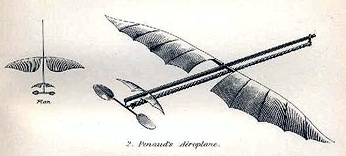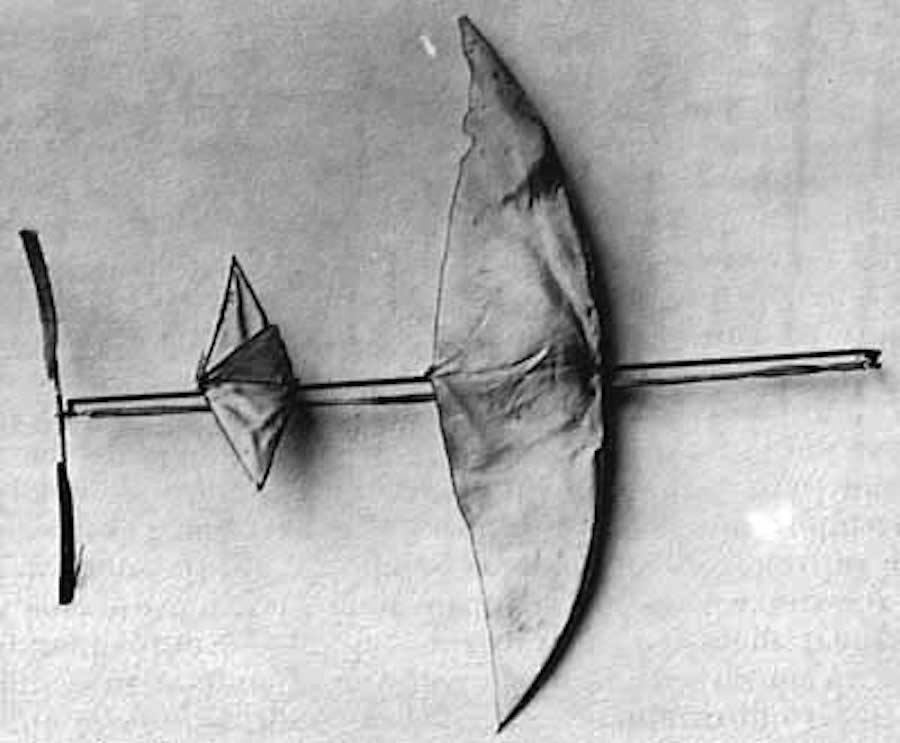
18 August 1871: Charles-Alphonse Pénaud demonstrated the first inherently stable airplane when he flew his model Planophore at a meeting of the Société de Navigation Aérienne at the Jardin des Tuileries, Paris, France.
At this demonstration, Pénaud’s Planophore flew 131 feet (39.9 meters) in 11 seconds.
The airplane was 20 inches (50.8 centimeters) long with a wing span of 18 inches (45.7 centimeters). The wings had a maximum chord of 4 inches (10.2 centimeters), and the total wing area was 0.53 square feet (0.049 square meters). The Planophore weighed 0.56 ounces (15.88 grams). The model had a two-bladed propeller with a diameter of 8 inches (20.3 centimeters) positioned at the tail in a pusher configuration. This was driven by a twisted rubber band (240 turns).

The center of gravity of the machine is placed a little in front of the center of pressure of the aeroplane, so that it tends to make the model descend an incline; but in so doing it lessens the angle of inclination of the aeroplane, and the speed is increased At the same time the angle of the horizontal rudder is increased, and the pressure of the air on its upper surface causes it to descend; but as the machine tends to turn round its center of gravity, the front part is raised and brought back to the horizontal position. If, owing to the momentum gained during the descent, the machine still tends upward, the angle of the plane is increased, and the speed decreased. The angle of the rudder from the horizontal being reduced, it no longer receives the pressure of air on its superior surface, the weight in front reasserts its power, and the machine descends. Thus, by the alternate action of the weight in front and the rudder behind the plane, the equilibrium is maintained. The machine during flight, owing to the above causes, describes a series of ascents and descents after the manner of a sparrow.
—Mr. Bennett, at the 1874 meeting of the Aeronautical Society of Great Britain, quoted in Progress in Flying Machines, by Octave Chanute, at Aeroplanes, Part VI, November 1892

The aircraft gained its stability (Octave Chanute called it “automatic equilibrium”) from several features that later became common in aircraft design. The wings curved upward toward the tips, creating a dihedral effect. A horizontal stabilizer at the rear was mounted with a lower angle of incidence than that of the the wings, resulting in a longitudinal dihedral effect. When the model airplane began to veer from a straight and level course, these dihedral characteristics caused it to correct itself.
Pénaud’s use of the twisted rubber band became a common feature of aircraft design models.
Charles-Alphonse Pénaud was born 31 May 1850 at Paris, France. He was the second of two sons of Capitaine de vaisseau Charles-Eugène Pénaud (later, vice-amiral) and Antoinette Louise Charlotte Huard de la Marre. Alponse’s older brother, Francis Eugène, followed their father and grandfather in the naval service, rising to the rank of contre-amiral. Because of a disability, Alphonse was not able to.
Alphonse Pénaud (as he is commonly known) became interested in flight at about the age of twenty years. He constructed a rotary-winged aircraft which he powered by using a twisted band of rubber. Following his Planophore, he built a rubber-band-powered ornithopter.
Pénaud designed a full-size airplane in the mid-1870s, but was unable to attract any investors.
Charles-Alphonse Pénaud committed suicide at his home in Paris, 22 October 1880. He was thirty years old.
© 2018, Bryan R. Swopes
Good Morning,
I have not seen any mention of the first Beaver being finished at the AV Roe factory in Downsview Ontario.
Can you tell me when the inaugural flight was for this aircraft.
I am a daily observer of your website,
I owe so much to it in enlarging my knowledge of aviation history.
Thank You
Thanks, Bruce. I don’t know a lot about the Beaver except that it is a classic. (I have a friend who is obsessed with the things!) A quick check with BAE Systems indicates that the first flight was 16 August 1947 at Downsview. The pilot was Russ Brannock. This will be a good subject for an article. Thanks for mentioning it.